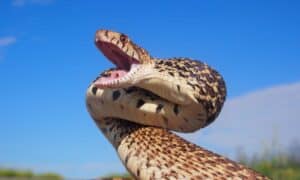Introduction
When it involves venomous snakes, Australia is home to a few of one of the most interesting and hazardous varieties on the planet. Among these, the Tiger Snake stands apart not only for its potent venom yet likewise for its appealing actions. Recognizing the habits of venomous snakes like the Tiger Serpent is critical for both wildlife lovers and those staying in areas where these serpents exist. This article looks into numerous elements of Tiger Serpent behavior, environment, identification, safety measures, and first aid methods in situation of a snake bite.
Understanding the Habits of Venomous Snakes Like the Tiger Snake
The Tiger Snake, clinically called Notechis scutatus, is notorious for its hostile nature when endangered. These serpents show a variety of actions that can be quite different from their non-venomous equivalents.
Characteristics of Tiger Snakes
The Tiger Serpent is easily recognizable because of its unique bands or stripes that resemble a tiger's markings. They can differ in shade from yellowish-brown to dark olive or black. This coloration serves not only as camouflage yet likewise as a warning signal to potential predators.
Adaptability to Environment
One amazing facet of their habits is their adaptability to numerous environments. Located mainly in coastal areas, marshes, and marshes throughout Australia and Tasmania, they can prosper in varied environments including metropolitan locations.
Hunting Techniques
Tiger Serpents are ambush predators mostly preying on fish, frogs, and small mammals. They have keen eyesight and an intense sense of scent which helps them in finding victim effectively.
Venom Composition
Their venom contains neurotoxins that impact the nerves, resulting in paralysis or fatality in smaller sized first aid pictures for snake bite - Skill's Training College pets. For people, immediate medical focus is important after a tiger snake bite as a result of its potentially lethal effects.

Natural Environment of Tiger Snakes
Preferred Locations
Understanding where these serpents reside clarify their behavioral patterns. The tiger snake habitat includes:
- Coastal regions Swamps Grasslands Urban locations with bountiful water sources
Seasonal Movements
During warmer months, Tiger Snakes are extra active as they indulge in sunlight or quest for food. In contrast, chillier months see them pulling back into hibernation sites.
Are Tiger Snakes Venomous?
Yes! The inquiry "are tiger snakes venomous?" often emerges among those not familiar with this types. Their poison is thought about among the most dangerous among all snake varieties worldwide.
Symptoms of a Tiger Snake Bite
If bitten by a tiger serpent, signs and symptoms may include:
- Localized pain Swelling at the bite site Nausea and vomiting Sweating and confusion
Immediate medical aid is important as neglected attacks can result in extreme health and wellness problems and even death.
First Help for Serpent Bites: Quick Reaction Guide
Knowing how to provide first aid for a snake bite might conserve somebody's life. Right here's what you need to do:
Step 1: Continue to be Calm
Keeping calm assists slow down heart price which reduces poison spread.

Step 2: Debilitate the Influenced Area
Keep the influenced snake bite symptoms arm or leg still and below heart level if possible.
Step 3: Call Emergency Services
Always look for professional clinical assistance promptly after a serpent bite.
First Help for Snake Bite Set Essentials
A well-appointed snake bite first aid kit need to consist of:
- A compression bandage Antiseptic wipes A pair of scissors A cold pack
Safety Safety measures: Preventing Serpent Bites in Australia
Awareness Programs
Educating neighborhoods concerning local serpent species and their actions can significantly decrease encounters resulting in bites.
Avoiding Unsafe Areas
Staying far from long turf during warmer months minimizes contact with snakes that could be resting or hunting.
Common Mistaken beliefs Regarding Tiger Snakes
Many individuals believe false impressions regarding the actions of tiger serpents cause unneeded worry. Below are some clarifications:

Myth 1: All Tigers Are Aggressive
Not all tiger serpents will present aggressiveness if left undisturbed; many prefer getting away instead of confrontation.
Myth 2: They Chase Humans
Tiger snakes do not proactively go after human beings; they might strike when they really feel intimidated yet will typically pull back if offered space.
Conservation Efforts Connected to Venomous Snakes
Conservation initiatives focus on enlightening areas about protecting local wild animals while reducing human-snake interactions.
Importance of Ecosystems
Understanding that venomous snakes play a necessary function in preserving eco-friendly equilibrium helps foster admiration as opposed to worry in the direction of them.
FAQs Regarding Tiger Snakes
What should I do if I encounter a tiger snake?- Maintain distance and gradually pull back without unexpected movements.
- While bites aren't extremely usual due to awareness efforts, they still take place every year within Australia.
- Baby tiger serpents can supply complete dosages of venom in spite of being smaller; thus care is suggested around them.
- They primarily take in frogs, fish, little creatures like rodents, and other reptiles.
- It's illegal in the majority of territories without correct licensing because of safety concerns regarding their venom.
- Wear sturdy boots and remain on marked trails; look before positioning hands or feet right into concealed rooms like rocks or logs.
Conclusion
Understanding the behavior of poisonous snakes like the Tiger Snake not just boosts our understanding but also promotes safety recognition among those living near their habitats. From recognizing their attributes, comprehending emergency treatment procedures adhering to a bite, with involving conservation efforts-- every facet plays an important function in cultivating coexistence with these interesting reptiles while valuing their place White crowned snake within our ecosystem.
As we deepen our understanding via education and experience, we contribute favorably toward guaranteeing both human security and wild animals preservation-- benefitting all events involved!